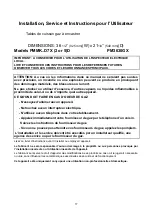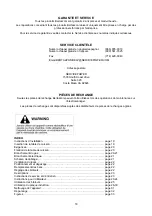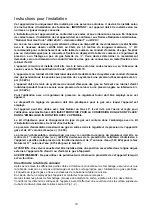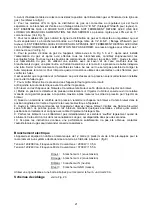
6
Attaching the hotplate
To prevent liquids from leaking accidentally into the underlying storage space, the appliance is equipped with
a special gasket. To apply this gasket, carefully follow the instructions in Fig. 3. Lay out the protective sealing
strips along the edges of the opening in the bench top and carefully overlap the strip end. (See Fig. 3). insert
the hotplate into the bench top opening. With a screwdriver assemble the brackets to the hotplate bottom by
means of the screws . (See Fig. 4A-4B). Slide the hooks into position and secure them with the screws.
Trim the part of the sealing strips which extend beyond the hotplate base
Gas connection
Before connecting the appliance to the gas supply, first remove the plastic plug on which is press-
fitted into the gas inlet union; to remove, just pull it off.
1. Check the ‘gas type’ sticker attached to the hotplate. Details of the injector sizes used are recorded on the
data plate located on the base of the appliance.
2. This appliance shall be installed in accordance with installation requirements of the local gas authority of
the appropriate installation code.
3. Before installing the hotplate consider the location of the gas supply and routing the gas line.(Refer fig.6)
4. For LPG models the gas supply is connected to the regulator which is supplied loose. The inlet connection
has a 1/2” B.S.P. male thread. IT IS ESSENTIAL THAT
THE ELBOW ON THE APPLIANCE BE HELD FIRMLY WITH A SPANNER WHEN CONNECTING THE
SUPPLY. DO NOT OVER TIGHTEN. The regulated pressure For LPG is 11” w.c. (See Fig. 5).
5. For NG models the gas supply is connected to the regulator which is supplied loose. The inlet connection
has a 1/2” B.S.P. male thread. IT IS ESSENTIAL THAT
THE ELBOW ON THE APPLIANCE BE HELD FIRMLY WITH A SPANNER WHEN CONNECTING THE
SUPPLY. DO NOT OVER TIGHTEN. The regulated pressure For NG is 4” w.c. (See Fig. 5).
6. For gas inlet position of appliance refer Fig 5, 6 and 7. After installing the gas supply and making all
connections check thoroughly for possible leaks. Turn all control knobs on the unit to ‘OFF’ position. Open
the valve on the gas supply. Using a soap and water solution check each gas connection one at the time, by
brushing the solution over the connection. Presence of bubbles will indicate a leak. Tighten the fitting and re-
check for leaks. If it is not possible to correct the leak, replace fitting. Under no circumstances use matches
or flame for checking leaks.
It is essential that the gasket and the pressure test point stopper are properly installed to avoid gas leakage
7.To checking inlet pressure at the appliance operate as follow:
a) Disconnect electric power before pressure checking be carried out.
b) Take off one of the gas burner cap and the relative flame spreader in order to get access to the
burner injector.
c) Put in position the pressure detector directly on the burner injector afterward open the relative burner
knob at maximum position keeping it pressed, then measure the outlet pressure from the burner
injector.
d) Once the pressure checking has been carried out, replace the burner cap and flame spreader in the
correct and original position and re-connect electric power to the appliance.
8. Turn on appliance control cock and light each burner. Check for a clear blue flame without yellow tipping.
If burners show any abnormalities check that they are located properly and in line with the injector nipple.
9. Sometimes the burners will not ignite immediately and seem to ‘blow’ slightly when they do ignite. This
usually due to air in the gas lines, which will clear itself within seconds.
10. If after following the instructions given, satisfactory performance cannot be obtained, contact the local
gas authority for advice and assistance.







































